2018 年 59 巻 10 号 p. 1537-1544
2018 年 59 巻 10 号 p. 1537-1544
As well as the most of other 3d late transition metals Fe is a good β-Ti stabilizer, has a large solid solubility in β-Ti and owing to the atomic size difference with Ti can enable significant solution strengthening. The structure and mechanical properties of Ti alloys containing significant amount of Fe (or Fe together with Co, Cu and other elements) are reviewed in the present work. At high content of the late transition metals (for example, more than about 15 at% of Fe) the structure of these alloys consist of the rounded primary dendrites of an ordered cP2 intermetallic compound and an eutectic consisting of the cP2 intermetallic compound and a supersaturated cI2 β-Ti solid solution. cP2+cI2 phase Ti–Fe alloys, their derivatives: Ti–Fe–Co, Ti–Fe–Cu, etc…, and cI2 β-Ti solid solution alloys containing Sn and Nb exhibit high compressive strength and plasticity. At lower Fe content a supersaturated β-Ti solid solution single phase structure is formed. However, these alloys also show good mechanical properties especially when alloyed with Sn and Nb. The structure and properties of various kinds of such alloys are discussed in the present paper.
Titanium, as a light and strong metal attracts significant attention of materials scientists for more than a half of a Century. Owing to its low density of 4.5 g/cm3 it is well-known for its high specific strength (strength to density ratio). Titanium alloys are as strong as steels, but significantly lighter. Typical commercial structural Ti-based alloys have an ultimate tensile strength slightly exceeding 1000 MPa and show plastic elongation of 10–15% to failure.1,2) These properties make titanium very attractive for structural applications. The relatively high melting point of this metal (1941 K) makes it useful as a refractory material. Titanium is also well known for its excellent corrosion resistance. Owing to their excellent properties titanium alloys are used in aircrafts, chemical vessels, spacecrafts, missiles, etc… Titanium having a hexagonal α hP2 (Pearson Symbol) structure at low temperature transforms forming the cubic cI2 β structure on heating above 1155 K.
There are several grades of pure or unalloyed titanium. Each grade has a different amount of impurity content. Tensile strengths vary from about 200 MPa to 500 MPa. As Al stabilizes α-phase α titanium alloys (based on HCP hP2 α-Ti) typically contain Al, as well as V and Sn. They are weldable and are commonly used for airplane parts and chemical processing equipment. Near α-alloys contain a small amount of ductile β-phase as they are also alloyed with 1–2% of β-phase stabilizers. α-Ti alloys and near α-Ti alloys show moderate mechanical strength but good fracture toughness and creep resistance.3)
α-β titanium alloys typically contain Al and 4–6% of β-phase stabilizers: Mo, V, W, Ta and can be heat-treated. They can be strengthened by heat treatment and aging by fine of α-phase precipitates during aging. Ti–6Al–4V is the most popular α-β Ti alloy. α-β Ti alloys have high tensile strength, fatigue strength and creep resistance. α-β alloys are applied for turbine blades, chemical equipment, airframes, chemical vessels, biomaterials,4) etc…
Alloys based on BCC cI2 β-Ti have good hardenability, good cold formability in the solution-treated state and high strength strengthened by precipitation hardening after aging.5,6) β-Ti alloys mostly contain β-phase due to presence of substation amount of β-phase stabilizers: Mo, V, W, Ta, Si. Typically they have yield strengths up to about 1300 MPa. β-Ti alloys are used for manufacturing aerospace components, high-strength aircraft parts, aircraft engine parts, chemical vessels and biomaterials.7)
Fe, as well as the most of other 3d late transition metals (LTM), is a good β-Ti stabilizer8) and has a large solid solubility in β-Ti, which can enable significant solution strengthening. The effect of relatively small additions of Fe to Ti alloys was reviewed two decades ago.9) It was shown that high strength values up to 1400 MPa can be achieved at Mo equivalent of 8%. Fe is also a very inexpensive alloying element. Also, compared to many other 3d LTM there is no other binary compound in Ti-rich area except for cP2 (Pearson Symbol) TiFe phase. Thus, alloys with Fe as one of the main alloying elements are reviewed in the present work.
Hypoeutectic Ti80Fe20 and Ti75Fe25, eutectic Ti70.5Fe29.5 and hypereutectic Ti67.5Fe32.5, Ti65Fe35, Ti62.5Fe37.5 and Ti60Fe40 alloys10) showed extremely high compressive strength close to that of metallic glasses11) and other alloys.12) Please, note that the chemical compositions are typically given in the atomic percents if otherwise is not indicated. The structure of the samples consists of a disordered BCC cI2 β-Ti solid solution containing a substantial amount of Fe and an ordered binary cP2 (B2) TiFe phase (Fig. 1).13) In a hypoeutectic alloy the primary dendrites of β-Ti solid solution are formed. The rounded primary dendrites of the cP2 TiFe (light color) phase are formed in the hypereutectic alloy (Fig. 2(a)). The disperse rounded TiFe phase is also a leading eutectic phase while β-Ti solid solution is formed between the TiFe eutectic rods. As has been mentioned, compared to many other 3d LTM there is no other binary compound in Ti-rich area (such as Ti2LTM with a complex structure) except for cP2 TiFe phase with a simple lattice and rounded morphology. Thus, Fe is a very special alloying element of Ti in this sense. Also, no omega phase14,15) is formed at high enough Fe content.
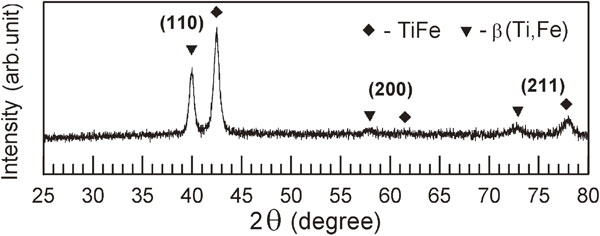
X-ray diffraction pattern of the Ti65Fe35 alloy. Reproduced from Ref. 13 with permission of Elsevier.
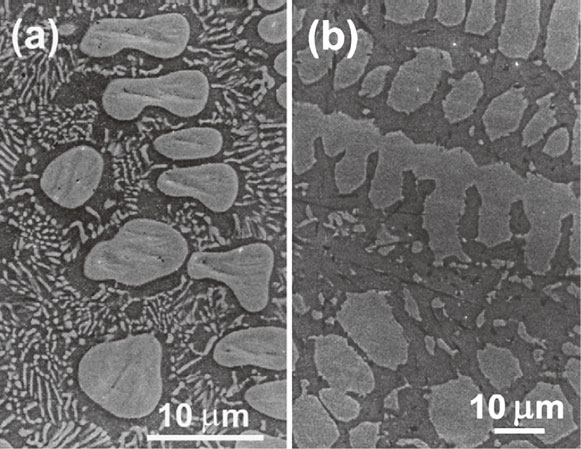
The structure of the Ti65Fe35 (a) and Ti64.7Fe34.8B0.5 (b) alloys, SEM. Reproduced from Ref. 17 with permission of Elsevier.
The structure of the Ti65Fe35 alloy and other Ti–Fe alloys is highly homogeneous throughout the sample. The average size of the dendritic cell of primary cP2 TiFe crystals is below 10 µm while the diameter of the eutectic TiFe rods is less than 1 µm. β-Ti solid solution, for example, in the Ti65Fe35 alloy is highly supersaturated. It contains about 24 at% Fe while cP2 TiFe phase contains 47 at% Fe. The chemical composition of the phases corresponds well to the data from the binary phase diagram.
The observed structure consisting of β-Ti and TiFe phase is nonequilibrium. However, Fe addition significantly lowers the β-Ti transus temperature in the phase diagram by about 200 K. As diffusive transformations become hampered at such a low temperature it leads to stabilization of the high-temperature β-Ti phase. For example, the estimated diffusion coefficient of Fe in β-Ti at the eutectoid point of 868 K is about 4 orders of magnitude lower than that at 1155 K.16)
The Ti70–65Fe30–35 alloys show an ultimate compressive strength exceeding 2 GPa, while yield strength (σ0.2) is about 1.8 GPa and plastic strain (ε) in a few percents (Table 1). Owing to its relatively low density of 5.8 g/cm3 Ti65Fe35 alloy shows specific strength of 380 kN·m/kg.

The addition of B increased mechanical strength (Table 1) but modified the structure of primary TiFe dendritic cells making them less rounded17) and especially the eutectic structure, even though B is insoluble in Ti. Also, though B is found to be a grain refining element in Ti alloys18) no such an effect was found in the Ti–Fe alloys. Instead the eutectic structure became much rougher (Fig. 2(b)). On the other hand it acts as an effective hardening element. A small addition of carbon was also found to be very efficient. The Ti65Fe34.1C0.9 alloy showed a high ultimate strength of 2750 MPa at the plastic strain of 10.7%.19) Chemical heterogeneity-induced plasticity was observed in Ti–Fe–Bi ultrafine eutectic alloys.20)
Vickers hardness of the Ti65Fe35 alloy is HV550 ± 10. The yield strength σ0.2 value of the Ti65Fe35 alloy corresponds very well to the value of 1800 MPa calculated as 9.8 HV/3. The microhardness of the primary TiFe dendrites is HV670 ± 35. This argues for an important influence of the cP2 TiFe phase on the mechanical properties the Ti65Fe35 alloy. The formation of a hard primary TiFe intermetallic compound and a disperse eutectic consisting of TiFe and the supersaturated β-Ti phases results in the high strength and enhanced ductility of the Ti65Fe35 alloy. Such good mechanical properties result from a high Fe content in β-Ti solid solution and the formation of primary TiFe compound with rounded dendritic morphology which is an important factor improving ductility of the hypereutectic Ti65Fe35 alloy. On the other hand, the Ti60Mn40 alloy also showed high ultimate strength of 1640 MPa but negligible plasticity21) owing to the needle-shaped morphology of the primary and eutectic TiMn crystals (non-cubic) which act as crack initiation sites upon deformation even though the structure is disperse.
The fracture surface of the Ti65Fe35 hypereutectic alloy at high magnification exhibits irregular fracture surface similar to that of fatigue failure of high-strength Ti-based alloys and high-strength steels.22) The fracture occurs along the plane of the maximum normal stress.13) However, the hypereutectic Ti65Fe35 alloy shows a high resistance to crack propagation and exhibits self-stabilization under deformation. The micro-cracks and deformation bands change their direction by about 45 degrees or block at the β-Ti/(primary TiFe) interface (see arrows marked with B and D in Fig. 3). The propagation of large cracks is blocked (marked as B) by primary TiFe dendrites having higher hardness compared to β-Ti. One should also mention that fine eutectic TiFe crystals are cut by the micro-cracks (Fig. 3). The eutectic Ti70.5Fe29.5 alloy having much more dispersed structure compared to Ti65Fe35 exhibited lower strength and ductility. It indicates importance of the carcass of the primary cP2 TiFe dendrites which lets an alloy to act like a composite material consisting of the hard primary TiFe dendrites embedded in the relatively ductile eutectic matrix.

Polished lateral surface of the hypereutectic Ti65Fe35 alloy sample after deformation to failure. The arrows show the points of deflection (D) and blockage (B) of the cracks and deformation bands. The primary cP2 TiFe dendritic cells are marked with [TiFe]. Reproduced from Ref. 10 with permission of Cambridge University Press.
Deformation of the eutectic matrix was also studied in detail.23) Plastic deformation of ultrafine eutectics was found to take place by dislocation slip inducing high dislocation density up to 1015 m−2. Also localized sliding caused formation of dislocation sub-boundaries, bending, lamellar sliding, shear banding, and failure of fine cP2 TiFe rods.
Taking into account good mechanical properties (high strength close to that of the bulk glassy alloys and good compressive plasticity) and low cost of Fe the Ti–Fe alloys, which dimensions are comparable to that of the structural engineering materials, are very attractive for mass production. The Ti70.5Fe29.5 and Ti67.79Fe28.36Sn3.85 eutectic alloys exhibit excellent corrosion resistance due to spontaneous passivation.24) Thus, they can also be used as chemically inert and biological materials.
The alloys with equal or close Fe and Co content exhibited the largest compressive ductility (see Table 1). Their microstructure mostly consists of an ordered cubic cP2 Ti(Fe,Co) phase which is a solid solution of Co in a binary TiFe compound and a disordered cI2 BCC β-Ti solid solution. The formation of the cF96 Ti2Co phase is hampered in the alloys with Fe/Co ratio exceeding 1. The βTi–TiFe eutectic point corresponds to 70.5 at% Ti while the addition of Co shifts it to 74 at% Ti if Co content is equal to Fe.
Phase composition areas, the microstructural evolution, phase equilibria and solidification pathways of the Ti–Fe–Co alloys were carefully analyzed recently.25,26) At high Co content this addition leads to the formation of cF96 Ti2Co phase and has significant influence on the microstructural development during casting of the Ti–Co–Fe alloys. Figure 4 shows the typical microstructure types observed in the ternary Ti–Fe–Co alloys.27) As in case of binary Ti–Fe alloys there are two structure constituents: primary dendrites and eutectic. β-Ti solid solution (dark color) is a primary phase in a hypoeutectic Ti76Fe12Co12 alloy (Fig. 4(a)). The rounded primary dendrites of the cP2 Ti(Fe,Co) (light color) phase are formed in the hypereutectic alloys, for example Ti70Fe20Co10 and Ti60Fe20Co20, as shown in Fig. 4(b,c). These two alloys represent two extreme types of hypereutectic alloys with significantly different volume fraction of the primary cP2 Ti(Fe,Co) phase. The other alloys with Fe/Co ratio RFe/Co ≥ 1 have the same structure consisting of the primary Ti(Fe,Co) phase and eutectic (Ti(Fe,Co)+β-Ti). The Ti76Fe12Co12 and Ti54Fe23Co23 alloys contain traces of the eutectic cF96 Ti2Co phase. The dispersed rounded cP2 Ti(Fe,Co) intermetallic phase is a leading eutectic phase while β-Ti solid solution is formed between the Ti(Fe,Co) eutectic rods. The average size of the dendritic cell of the primary Ti(Fe,Co) phase is 10–20 µm depending upon alloy composition while the diameter of some Ti(Fe,Co) eutectic rods is submicron. Similar to Ti–Fe alloys the structure of the Ti–Fe–Co alloys is also highly homogeneous throughout the samples.
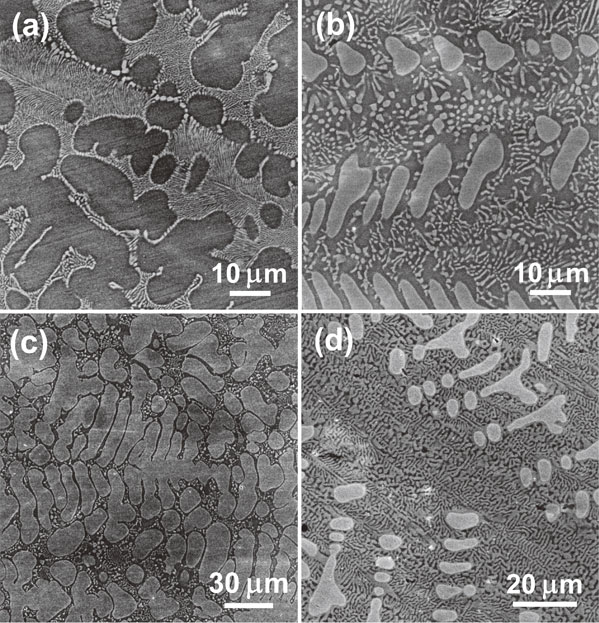
SEM images (in secondary electrons) of typical structure types observed in the studied alloys: hypoeutectic (a) Ti76Fe12Co12 and hypereutectic (b) Ti70Fe20Co10, (c) Ti60Fe20Co20 and (d) Ti70Fe10Co20 alloys. Reproduced from Ref. 27 with permission of Elsevier.
The results of mechanical test of Ti–Fe–Co alloys27) are also shown in Table 1 while three selected strain-stress curves under compressive test are shown in Fig. 5. There is an optimum concentration range in which alloys posses both high strength exceeding 2000 MPa and plastic deformation of about 15% which is higher than that in binary Ti–Fe alloys. Thus, the addition of Co improves the room-temperature plasticity of the alloy.
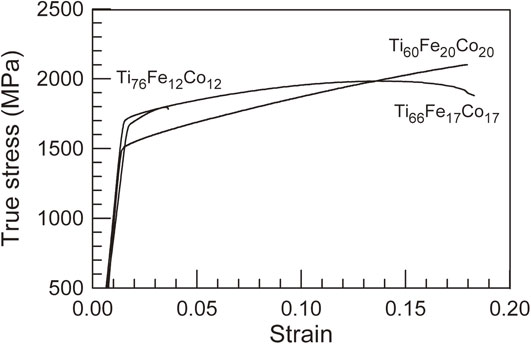
The true stress-strain curves of the Ti–Fe–Co alloys. Reproduced from Ref. 27 with permission of Elsevier.
Vickers hardness of the Ti70Fe15Co15 alloy is HV540 ± 15. The σ0.2 value of 1750 MPa corresponds very well to the value of 1760 MPa calculated by the following formula for yield strength σ0.2 = 9.8 HV/3. The hardness of the primary Ti(Fe,Co) dendrites is HV720 ± 40 while Vickers hardness of the Ti(FeCo)+β-Ti eutectic is only HV530 ± 20. Owing to its relatively low density of 5.6 g/cm3 the Ti70Fe15Co15 alloy shows a very high specific strength of 350 kN·m/kg.
The addition of Cu makes the eutectic morphology rougher. Although Cu is a more preferable element owing to its low cost28) the Ti70Fe15Cu15 alloy showed lower strength and plasticity compared to Co-bearing alloys. However, Ti–Fe–Cu alloys with high Fe/Cu ratio also showed high strength and good plasticity, especially in the heat treated state at 1173 K.29) The compressive strength and compressive strain of the heat-treated Ti67Fe27Cu6 alloy are 2130 MPa and 24.5%, respectively.
Once again the high strength values of the ternary alloys result from the high late transition metals contents in the supersaturated β-Ti solid solution (solution hardening) and the high hardness of the cP2 intermetallic (IM) compound. The β-Ti solid solution phase exhibits a dislocation-type deformation mechanism while the cP2 IM phase deforms by localized shear deformation and also undergoes accommodation deformation likely by intergranular sliding.
The structure of the hypereutectic Ti–Fe–Co alloys show a high resistance to crack propagation and exhibits self-stabilization under deformation. An absence of a hard carcass of the primary Ti(Fe,Co) dendrites in the hypoeutectic Ti76Fe12Co12 alloy leads to its lower strength and ductility compared to the hypereutectic Ti60Fe20Co20 and Ti66Fe17Co17 alloys (see Fig. 4 and 5 as well as Table 1). It indicates that the carcass of the primary Ti(Fe,Co) dendrites (a phase with higher hardness) is necessary for the achievement of higher strength and ductility compared to hypoeutectic alloys. Thus, under deformation the hypereutectic Ti–Fe and Ti–Fe–Co alloys act like two kinds of composite materials: hypereutectic having the hard carcass of the intermetallic phase in the softer eutectic matrix, and hypoeutectic having the soft carcass of β-Ti solid solution in the harder eutectic matrix.
The high strength values exceeding 2000 MPa are superior to those of the conventional Ti-based alloys having α-Ti, β-Ti or α+β-Ti structure and intermetallics-based alloys (Ti3Al and TiAl,30,31) for example). At the same time, plasticity of the Ti–Fe–Co alloys exceeds significantly that of Ti-based bulk metallic glasses.
Ternary Ti–Fe–Co alloys exhibit twice higher ductility compared to the binary Ti–Fe alloys though the overall structure and the morphology of the cP2 IM compound (primary and eutectic) in Ti70Fe15Co15 and Ti65Fe35, for example, are very similar. Moreover dissolution of Co in cP2 TiFe phase practically does not change its lattice parameter owing to similar atomic size of Fe and Co. The increase in strength may be connected with a slightly larger average size of the dendritic cell in Ti–Fe–Co alloys compared to Ti–Fe alloys. As has been mentioned the cracks are blocked by rough primary cP2 dendrites while they cut fine eutectic cP2 rods.
The deformation behavior and fractography of the Ti70Fe15Co15 alloy have been studied in detail.32) Quite a good lattice correspondence was observed in the case of the eutectic cP2 IM and cI2 solid solution phases.33) An eutectic colony containing cP2 IM rods embedded in the cI2 phase is seen in Fig. 6(a).33) The ellipsoidal reflections of cP2 phase arose from the rod-shaped morphology of this phase Fig. 6(b). As there is only about 6% difference in the lattice parameters between β-Ti and Ti(Fe,Co) phases and their crystallographic structure is very close to each other one can expect formation of a semicoherent interface between these phases leading to low coherency stresses.

(a) Bright-field TEM image of the eutectic colony in Ti70Fe15Co15 alloy sample. (b) SAED pattern taken from both rod-shaped cP2 and irregular cI2 phase. Reproduced from Ref. 34 with permission of Elsevier.
Figure 7 exhibits the diffraction patterns taken from the eutectic phases after deformation of the Ti60Fe20Co20 alloy to fracture. Strong reflections in Fig. 7(a) and (b) belong to distorted cP2 compound and β-Ti cubic lattice, respectively. The detailed TEM analysis indicates the deformation-induced transformation (Fig. 7(a,c)) in some areas of the sample forming the nanoscale mP4 particles (the lattice parameters are close to those of mP4 NiTi phase) within the deformation bands34) in the distorted cP2 phase.35) cI2 Ti phase also partially transforms to hP2 Ti (Fig. 7(b)) upon deformation.

SAED patterns taken from the eutectic colony in the Ti60Fe20Co20 alloy sample after compression to fracture. (a) from the rod-shaped cP2 phase, (b) from the irregular cI2 phase and (c) from both phases at the same time (the diffraction patterns are superimposed). Reproduced from Ref. 35 with permission of Elsevier.
Formation of the nanoscale amorphous phase of about 3–7 nm in size was found within the heavily deformed areas of the Ti60Fe20Co20 alloy sample as shown in the HRTEM image (Fig. 8). The wave vector corresponding to the amorphous halo of about 27 nm−1 is close to that observed in Ti–Cu–Ni and Ti–Cu–Ni–Sn glassy alloys.36)
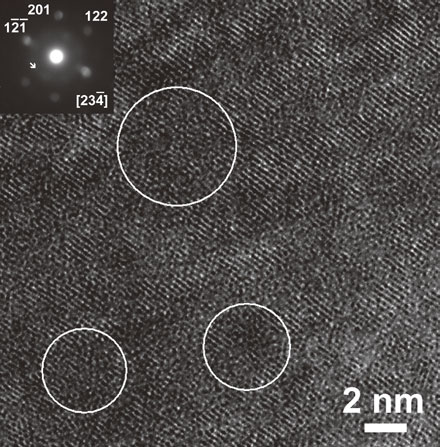
HRTEM image of the deformed area of cP2 phase in the Ti60Fe20Co20 alloy sample after compression to fracture. The circles outline nearly globular areas of the amorphous structure. The lattice is heavily distorted. A nanobeam diffraction pattern (probe size 5 nm) from the nanoscale amorphous region is shown in the insert. An amorphous halo is marked with an arrow. Reproduced from Ref. 35 with permission of Elsevier.
The deformation-induced martensitic transformations were observed in various Ti-based alloys.37,38) The formation of the martensitic phase can also make an influence on the improved ductility of the alloy. However, one should suppose that this is only a minor mechanism as the alloys with high volume fraction of cP2 phase exceeding about 80% are totally brittle.
The mechanical properties also were tested at the elevated temperature. A yield strength value of Ti70Fe15Co15 alloy at 773 K is 760 MPa. This value exceeds those of the strongest commercial Ti-based alloys.39) The phase composition of the alloy remained unchanged after the compressive test.
Ti–Fe–Co–Nb–Al alloys with ultrafine lamellar eutectic matrix were also produced by solid-solid sintering of mechanically alloyed glassy powder. They exhibit ultra-high yield strength values up to 2050 MPa and compressive plasticity of 19.7%. The (Ti63.5Fe26.5Co10)82Nb12.2Al5.8 bimodal alloy exhibited tensile plastic strain of 1.6% and an ultimate tensile stress of 920 MPa.40)
Sn was also found to be a useful alloying element for Ti–Fe alloys.41,42) The addition of 3.85 at% Sn to the binary Ti–Fe eutectic slightly decreases strength but considerably improves the compressive plasticity from 2.1% to 9.6% strain to failure. The Ti65Fe35 and other similar alloys were further alloyed with Sn and other metals.24,43) Sn was found to refine Ti–Fe eutectic.
The Ti67Fe14Co14Sn5 alloy showed high plasticity of 24% (Table 1) significantly improved by Sn addition.44) Its microstructure consists of the primary cP2 Ti(Fe,Co) intermetallic phase and eutectic (Fig. 9).45) The average size of the dendritic cell of the primary Ti(Fe,Co) phase is about 10 µm. Sn enlarges the lattice parameter of β-Ti solid solution reduced by Fe and Co. Although Sn makes structure of the Ti70Fe15Co15 alloy rougher it does not deteriorate plasticity. On the other hand the Ti–Fe–Cu–Sn system alloy shows lower strength and plasticity (Table 1). Ti–Cu–Fe–Sn–Nb alloys at high Cu and Fe contents exhibit the yield strengths of 1450–1500 MPa but smaller plastic strain.46)

SEM micrograph of the polished cross-section of the Ti67Fe14Co14Sn5 alloy. Reproduced from Ref. 45 with permission of Elsevier.
The fractography images of the Ti67Fe14Co14Sn5 alloy showed that vector normal to the compressive fracture surface changes from about 90 degrees to the load direction (fracture occurs along the plane of the maximum normal stress) to about 45 degrees to the load direction (fracture occurs along the plane of the maximum shear stress).
In order to increase plasticity single β-Ti phase Ti–Fe and Ti–Fe–Co alloys were also prepared. For example, β-Ti single phase is formed in the Ti90Fe10, Ti88Fe12, Ti90Fe5Co5 and Ti86Fe7Co7 alloys. These alloys were not destroyed in compression and their yield strength was only in the range of 1000–1250 MPa.
The Ti–Fe–Sn–Nb system comprises a very interesting group of high-strength alloys.47,48) A Ti–Fe–Nb–Sn alloy was suggested to be applicable for bioimplants.49) The Nb-containing alloys exhibit simultaneously improved compressive mechanical properties, i.e. high yield strength of 1.9–2.2 GPa and fracture strength of 2.2–2.6 GPa together with large plasticity of 6–13%.50) The (Ti70.5Fe29.5)93.15Sn3.85Nb3 alloy exhibited an ultimate compressive strength of 2.36 GPa at 15% plastic strain.51) The (Ti65Fe35)93.15Sn3.85Nb3 alloy displayed an ultimate compressive strength of 2.7 GPa and a compressive plastic strain of 15%.52) As in case of the Ti67Fe14Co14Sn5 alloy lamellar eutectic structure is modified by the addition of Sn and Nb towards a globular structure. However, high strength of the alloys with intermetallic compounds (Table 2)53) is expected. Rather surprising was high strength obtained in the as-cast β-Ti alloys containing 12 and 14 at% Fe (Table 2) with a minor fraction of α′′ phase (below 1 vol%).54) The mechanical strength and specific strength of various Ti–Fe-based alloys are summarized in Fig. 10.

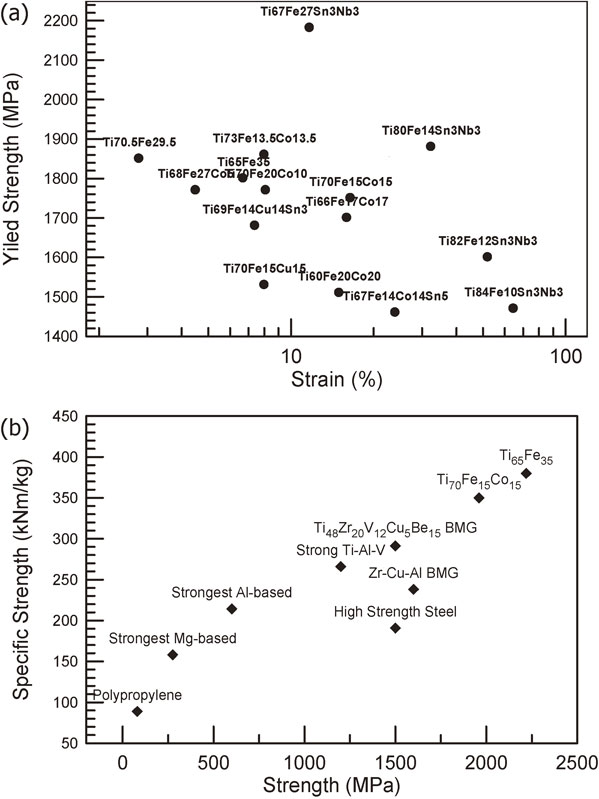
Strength (a) and specific strength (b) diagrams of the Ti–Fe-based alloys.
The Ti84Fe10Sn3Nb3 alloy with the lowest Fe content is suggested to exhibit both slip and deformation twinning to enhance its plasticity. The excellent mechanical strength of these alloys is partly attributed to the solution hardening of the supersaturated β-Ti and most importantly to the effect of precipitation hardening by the formation of possible pre-precipitates (Fig. 11). The high density of lattice strain, dislocations and distortions are observed around the pre-precipitates which are supposed to act as strong barriers restricting dislocation propagation.
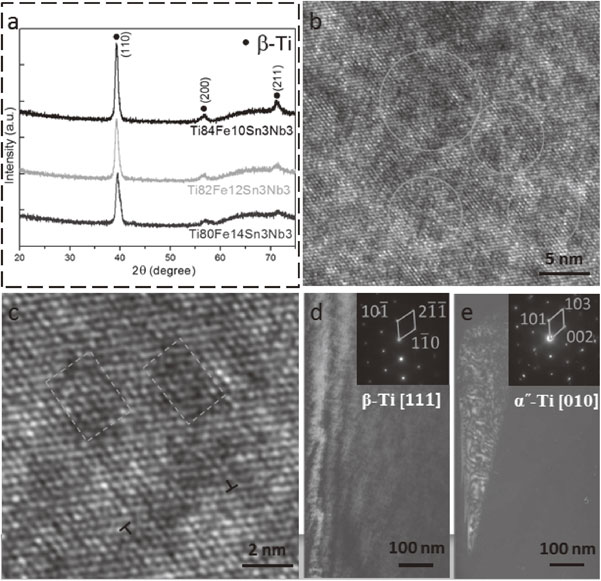
(a) XRD patterns of the as-cast Ti80Fe14Sn3Nb3, Ti82Fe12Sn3Nb3 and Ti84Fe10Sn3Nb3 alloys showing the predominant β-Ti phase. (b) High-resolution TEM micrograph of the Ti84Fe10Sn3Nb3 alloy in as-cast state; (c) HRTEM micrograph in a high magnification illustrates the dislocations and the distorted zones. Dark-field images of (d) β-Ti and (e) α′′-Ti. The insets show the corresponding selected-area diffraction patterns. Reproduced from Ref. 54 with permission of Elsevier.
Ultimate tensile strength and elongation to fracture of Ti–8Fe–8Ta, Ti–8Fe–8Ta–4Zr, and Ti–10Fe–10Ta–4Zr (here chemical compositions are given in mass%) after solution treatment were 1070 MPa and 10%, 1050 MPa and 10%, and 1090 MPa and 6%, respectively.55) β-Ti type Ti–5Fe–3Nb–3Zr alloy exhibiting a Young’s modulus of around 76 GPa is suggested for biomedical applications.56) These alloys show high resistance to pitting corrosion in biological environments. The corrosion resistance of these alloys is higher than that of Ti and Ti–6Al–4V. The Ti–8Fe–8Ta and Ti–8Fe–8Ta–4Zr are suggested as promising biomaterials. Aging of β-Ti phase at 750°C for 80 h lead to precipitation of cP2 TiFe particles of less than 100 nm in size in a Ti–Fe–Mo alloy leading to a very high compressive proof stress of 1.9 GPa.57)
Cu is also used to alloy Ti.58) Low-alloy-type (with relatively low content of the alloying elements) α-β Ti Ti94Fe3Cu3 alloy produced by tilt-casting method (β-Ti in the as-cast state) and subjected to subsequent thermo-mechanical treatment by hot dual-axial forging at 1173 K showed a high ultimate tensile strength value of 1200 MPa and percentage elongation of 9%.59) It is shown that the intensive forging treatment is equivalent to severe plastic deformation and provides a nanostructured state of the alloy leading to significantly improved mechanical properties. The dual-axial forging method does not require complex and expensive tools and allows obtaining relatively inexpensive Fe-bearing alloys with good mechanical properties by using the existing technology and forging equipment. The Ti94Fe3Cu3 alloy with a small amount of B having α+β titanium structure showed acceptable tensile strength level up to 950 MPa and tensile elongation of 5.2%.60) Its compressive mechanical properties in the dual-axially forged at 1173 K, annealed at 1073 K and quenched state are very close to the intermetallic-type alloys (Table 3).

In some cases α-stabilizing element Al is also added to β-Ti alloys to promote formation of α+β structure. The Ti88.5Fe5Cu5Al1.5 alloy with β-Ti structure forged at 1273 K showed high tensile strength up to 1140 MPa and tensile elongation of 2%.61) As β-Ti phase is predisposed to have large grain size the grain size refinement procedure by forging is considered an important procedure in this alloy.
Also, rather surprisingly the Ti94Fe3Cu3 alloy exhibited a wide passivation region with the corrosion current density of 0.124 µA·cm−2. This alloy also rather surprisingly exhibits a similar or even higher level of cell proliferation compared to the Ti–6Al–4V alloy. The density of the cells cultivated on the Ti94Fe3Cu3 alloy surface is slightly higher than that on the Ti–6Al–4V alloy.62) Thus, possible harmful effect of Cu is not evident at such a low Cu content, and even at a higher Cu concentration.63)
Ti alloys with Fe comprise a very attractive group of materials. The Ti–Fe-based alloys having a non-equilibrium phase composition consisting of the ordered cP2 IM phase and the disordered cI2 β-Ti solid solution exhibit an excellent combination of compressive mechanical strength and ductility. At room temperature these hypereutectic alloys exhibit the high ultimate mechanical strength values of 1.5–2.5 GPa, high specific strength up to 380 kN·m/kg and plastic deformation up to 24%. The high strength values result from the high Fe and other late transition metals contents in the supersaturated β-Ti solid solution (solution hardening) and the high hardness of the cP2 intermetallic compound having a rounded dendritic morphology. The formation of a composite-like structure with a hard carcass of the intermetallic phase in the relatively soft eutectic matrix enabled both high strength and ductility. The β-Ti solid solution phase exhibited a dislocation-type deformation mechanism, while the cP2 IM phase deforms by localized shear deformation and also undergoes accommodation deformation. The rough primary dendrites and eutectic rods of the cP2 intermetallic phase act as efficient barriers for shear strain and crack propagation while fine eutectic rods of submicron size can be cut by deformation bands and cracks. The additions of Co and Cu substituting for Fe further improve room-temperature plasticity and do not lead to the formation of a Ti2Co compound at high enough Fe content. β-Ti solid solution type Ti–Fe–Sn–Nb alloys exhibited high yield stress (1.88 GPa in the case of Ti80Fe14Sn3Nb3 alloy) and large compressive plasticity. Significant strain-hardening was also observed along with large plastic deformation. These findings provide an efficient way for the designing a new generation of strong β-Ti alloys. Low alloy type Ti–Fe–Cu alloys subjected to thermo-mechanical treatment by hot dual-axial forging showed a high ultimate tensile strength, and significant elongation. These and some other alloys also show high corrosion resistance and good biocompatibility suitable for biological applications.